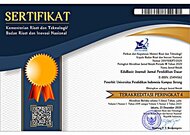Parents' Views on YouTube in Early Childhood Education
Abstract
In this digital era, the internet has become a basic need for everyone globally. Not only adults, but early childhood also often use the internet to find entertainment. One of the applications that children often use to find entertainment is YouTube. There are various kinds of content on YouTube, including movies, gaming videos, educational videos, vlogs, etc. So that parents or teachers also use YouTube as a learning medium for children. This is what attracted the attention of researchers to identify and describe the reason parents give YouTube videos to their children. The purpose of this study is to determine parents’ views on YouTube and relate them to early childhood education. This research was quantitative research using the survey method. The research instrument used is a questionnaire delivered via Google Forms. In this study, it was found that parents have given YouTube access to their children at an early age by the reason to stimulate children's development. Through mobile phones, children were introduced to and started to actively access YouTube content such as children's songs almost every day. On the other hand, parents also recognized that they found side effects on their children being YouTube users. Moreover, there were still parents who are not aware on accompany their children when accessing various YouTube content. Appropriate YouTube content can have a good impact on children's growth and development, such as being able to communicate well, being active, knowing religious values, and imitating good character figures. But keep in mind that parents must always accompany their children and direct them to watch YouTube according to their needs.
Keywords
Full Text:
PDFReferences
Al-Ameri, A. M., & Rababah, L. M. (2020). The effect of using youtube on developing elementary students vocabulary. Education and Linguistics Research, 6(1), 129–139.
Amran, A., Marheni, E., Sin, T., & Yenes, R. (2020). Kecanduan game online Mobile Legends dan emosi siswa SMAN 3 Batusangkar. Jurnal Patriot, 2(4), 1118–1130.
Chusna, P. (2017). Pengaruh media gadget pada perkembangan karakter anak. Dinamika Penelitian: Media Komunikasi Penelitian Sosial Keagamaan, 17(2), 315–330.
Febrianti, C., Sudradjat, A., & Sari, R. (2020). Perancangan e-learning sebagai media pembelajaran. Jurnal Infortech, 2(2), 171–176.
Ilyas, M., & Putri, M. E. (2020). YouTube channel: An alternative social media to enhance EFL students’ speaking skill. J-SHMIC: Journal of English for Academic, 7(1), 77–87.
Isni, R. A. F., & Anugrah, D. (2021). Penanganan kecanduan gadget pada anak usia sekolah selama masa pandemi covid-19 di Desa Wantilan, Kabupaten Subang. Proceedings UIN Sunan Gunung Djati Bandung, 1(28), 149–165.
Julita, M., Yuline, Y., & Yusuf, A. (2018). Dampak negatif penggunaan gadget pada peserta didik SMP Negeri 13 Pontianak. Jurnal Pendidikan dan Pembelajaran Khatulistiwa, 8(11), 1–8.
Kardefelt-Winther, D. (2017). How does the time children spend using digital technology impact their mental well-being, social relationships and physical activity ? An evidence-focused literature review. Innocenti Discussion Paper, 2017-02, 1–37.
Kurniati, M., & Nuryani, N. (2020). Pengaruh sosial media YouTube terhadap pemerolehan bahasa anak usia 3-4 tahun (Studi pada anak speech delay). Fon: Jurnal Pendidikan Bahasa dan Sastra Indonesia, 16(1), 29–38.
Mastanora, R. (2020). Dampak tontonan video YouTube pada perkembangan kreativitas anak usia dini. Aulada: Jurnal Pendidikan dan Perkembangan Anak, 2(1), 47–57.
Noor, F., Mumpuni, R. A., Laksmiwati, I., & Amaliyah, A. (2020). Pendampingan ibu bekerja terhadap penggunaan youtube pada anak. Komuniti: Jurnal Komunikasi dan Teknologi Informasi, 12(1), 41–50.
Papadamou, K., Papasavva, A., Zannettou, S., Blackburn, J., Kourtellis, N., Leontiadis, I., Stringhini, G., & Sirivianos, M. (2020). Disturbed YouTube for kids: Characterizing and detecting inappropriate videos targeting young children. Proceedings of the International AAAI Conference on Web and Social Media, 14(1), 522–533.
Pritandhari, M. (2018). Analisis intensitas penggunaan gadget dan pemanfaatan internet terhadap motivasi belajar. Promosi: Jurnal Program Studi Pendidikan Ekonomi, 6(1), 20–27.
Putra, A., & Patmaningrum, D. A. (2018). Pengaruh YouTube di smartphone terhadap perkembangan kemampuan komunikasi interpersonal anak. Jurnal Penelitian Komunikasi, 21(2), 159–172.
Rahmawan, D., Mahameruaji, J. N., & Janitra, P. A. (2018). Potensi YouTube sebagai media edukasi bagi anak muda. Edulib: Journal of Library and Information Science, 8(1), 81–98.
Rani, E., & Rahayu, W. (2021). Penggunaan video YouTube sebagai media pembelajaran bagi anak usia dini di masa pandemi covid-19. Jurnal Pendidikan Tambusai, 5(3), 6150–6156.
Saihu, M. (2021). Dampak negatif media sosial YouTube terhadap perilaku peserta didik. Al Amin: Jurnal Kajian Ilmu dan Budaya Islam, 4(2). 418–434.
Saraswati, S. W. E., Setiawan, D., & Hilyana, F. S. (2020). Dampak penggunaan smartphone pada perilaku anak di Desa Muktiharjo Kabupaten Pati. WASIS: Jurnal Ilmiah Pendidikan, 2(2), 96–102.
Setianingsih, S. (2018). Dampak penggunaan gadget pada anak usia prasekolah dapat meningkatan resiko gangguan pemusatan perhatian dan hiperaktivitas. Gaster: Jurnal Kesehatan, 16(2), 191–205.
Shirinkam, M. S., Shahsavarani, A. M., Toroghi, M., Mahmoodabadi, M., Mohammadi, A., & Sattari, K. (2016). Internet addiction antecedents: Self-control as a predictor. International Journal of Medical Research & Health Sciences, 5(5), 143–151.
Szeto, E., Cheng, A. Y. N., & Hong, J. C. (2016). Learning with social media: How Do preservice teachers integrate YouTube and social media in teaching? Asia-Pacific Education Researcher, 25(1), 35–44.
Tempola, F., Muhammad, M., & Mubarak, A. (2020). Penggunaan internet di kalangan siswa SD di Kota Ternate: Suatu survey, penerapan algoritma clustering dan validasi DBI. Jurnal Teknologi Informasi dan Ilmu Komputer, 7(6), 1153–1160.
DOI: https://doi.org/10.17509/ebj.v4i2.40707
Refbacks
- There are currently no refbacks.
Copyright (c) 2022 Universitas Pendidikan Indonesia
This work is licensed under a Creative Commons Attribution 4.0 International License.
This journal is indexed by




.png)




.png)
1.png)


1.png)

.png)